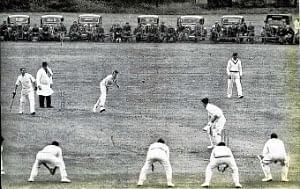
The A-Z of Derbyshire Cricket - G is for Gladwin: Cliff Gladwin

There’s only one contender for the G-Man.
I’ll admit that Peter Gibbs was one of the more aesthetically pleasing batsmen of my formative years as a fan. He seemed to have more time than most and possessed a glorious cover drive. Indeed, that classic style was at odds with the more functional, perhaps attritional method of some contemporaries, but as a cricketer and contributor to the county’s fortunes he was light years behind my number one, Cliff Gladwin.
Curiously, Gladwin’s father, Joe, played with Tom Forrester, my ‘F’ of choice, but the boy’s talents far exceeded those of the father. Cliff made his first class debut in 1939 prior to the Second World War, but had to wait long years until hostilities ended and he was able to resume his first-class career. He was thirty when cricket resumed in 1946, but he took a hundred wickets that season and did so with metronomic regularity for the remainder of his career.
Although a solidly built man, he was light on his feet and had a short run up, followed by an easy action that meant he could bowl long spells. This can be seen on the Pathe news site by following this link:
http://www.britishpathe.com/record.php?id=29095
Gladwin can be seen bowling at two minutes fifteen seconds, playing against New Zealand in 1949.
His record speaks for itself and year in, year out he bowled with rare control and hostility. There was no real pace, but Gladwin’s late swing saw many fall victims in his leg-trap, where he was wonderfully supported by Donald Carr, Alan Revill and Derek Morgan. 1653 first-class victims at eighteen each is testimony to his consistency and sustained hostility and no batsman in the 1950’s fancied coming to Derby or Chesterfield. Various accounts tell of injuries ruling players out when faced with Cliff and Les Jackson on a green top – and that was before the game!
One of the best accounts of Derbyshire watching in the 1950’s was published in the Derby Telegraph some time ago and was written by someone called ‘S.Williams’ Part of this description can be seen below:
“The County Ground at Derby in the 1950s was a dump in the real sense of the word, a place of gentle decay.
The ramshackle former racecourse buildings were often home to no more than a few dozen spectators because, when the weather was unkind, watching – and, no doubt, playing – at the County Ground was not for the faint-hearted.
The wind came whipping off the old racecourse, straight from the Urals it seemed, cutting through you like a knife. The facilities were awful: toilets that have been described as French Colonial; catering which made the worst that the old British Railways could offer look like a Savoy Grill buffet. Finding shelter from wind and rain meant huddling at the back of the Grandstand while keeping one eye on the toilet habits of dozens of pigeons cooing happily in the cavernous roof. Once settled on a fine day, though, I had eyes only for my hero.
It is exactly 50 years since I last saw him in action. His run-up began easily – no stuttering start like so many of his profession – and gathered graceful speed until his body moved into that classic arc and his broad shoulders propelled the ball on its way.
Quite simply, Cliff Gladwin was one of the finest cricketers that I have ever seen. Whenever Gladwin was on the field, something was always likely to happen, whether it was shattering the stumps, clouting a few late runs to frustrate the opposition, or running somebody out. In short, Gladwin was an entertainer, a character to help brighten up those austere years after the Second World War.”
Gladwin played eight Test matches, taking 15 wickets at 38, figures that suggest he was just short of the highest class. Yet his greatest moment came in South Africa in 1948-49, when he scored a leg-bye off the last ball of the Durban Test to win the game.
“Coometh the hour, coometh the man,” he had announced on arrival at the crease, and he was as good as his word. He was 33 when he played the last of his Tests the following summer, but was one of the best bowlers in the country throughout the 1950s and could – perhaps should – have received greater recognition.
Whereas his partner in crime Les Jackson was philosophical about mistakes in the field, Gladwin could be fairly hard on team mates.
“Four for thirty-seven in nineteen overs…could have been four for thirty-three if that bugger had kept his legs together…” He knew his analysis TO THE RUN at the end of the innings and instilled in the young Harold Rhodes the need to make the batsman play everything and give nothing away. Rhodes, like Derek Morgan and Edwin Smith, often recounted how they got many wickets from batsmen taking a chance against them, having faced the opening pair for an hour or more with hardly a ball from which to score.
He could be outspoken, but people will always accept someone doing that when their actions on the pitch justify it. Cliff Gladwin set a standard of parsimony that has seldom been exceeded and is rightly regarded as one of the club’s greatest ever players.
An easy choice for best G. What would we give for another of his ilk?
PS – the picture above shows Gladwin bowling for Derbyshire in his pomp, with the field set for a bowler in command of his game.